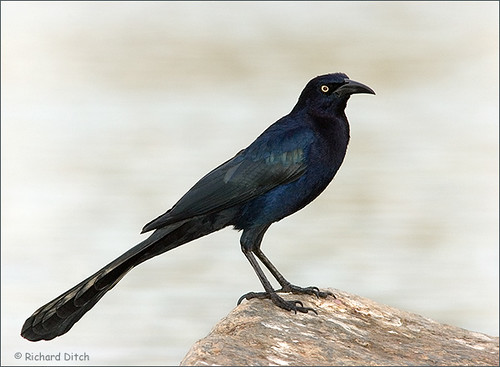tags: Great-Tailed Grackle, Quiscalus mexicanus, birds, mystery bird, bird ID quiz
[Mystery bird] Great-Tailed Grackle, Quiscalus mexicanus, photographed in Arizona. [I will identify this bird for you tomorrow]
Image: Richard Ditch, 2 January 2006 [larger view].
Date Time Original: 2006:01:02 15:42:48
Exposure Time: 1/159
F-Number: 10.00
ISO: 200
Please name at least one field mark that supports your identification.
Rick Wright, author of Aimophila Adventures and Managing Director of WINGS Birding Tours Worldwide, writes:
Start at the reeeaaarrr--among the blackish birds of North America (and there aren't that many), only the large grackles have tails this extravagantly long and this extravagantly graduated. The glossy plumage makes this a male.
Where Great-tailed and Boat-tailed Grackles overlap on the northwestern shores of the Gulf of Mexico, the two species differ in eye color: yEllow in grEat-tails, dArk in boAt-tails. On the east coast, however, most male Boat-tailed Grackles have bright yellow eyes, and could easily be mistaken for Great-tailed Grackles, a species inexorably on the move north and east.
Head shape is often helpful. The photo of our mystery bird shows the nice flat forehead sloping into the culmen that is characteristic of Great-tailed Grackle; Boat-tails have domed heads, a feature that is often surprisingly easy to see.
In life, this time of year we might find this male caught up in the enthusiasms of spring. His song would be harsh and varied, full of weird unbirdlike crashings and thrashings -- unlike the more tasteful churring chant of Boat-tailed Grackle. And if the spirit was really upon him, our mystery bird would display, bowing deep and keeping the wings low; Boat-tailed Grackles are less controlled, raising their wings above their back in full display.
Great-tailed Grackles such as our mystery bird are a relatively recent addition to Arizona's avifauna. Next year is the 75th anniversary of the arrival of this beautiful and charismatic bird in the state from its historic range in Mexico. Though widespread, grackles are still restricted to habitats with water and trees, making them rare outside of cities and towns. They are common, for example, along the strip malls of Oracle Road here in Tucson -- and utterly, entirely non-existent in the desert suburbs less than a mile off that road.
- Log in to post comments


Beautiful Great-tailed Grackle.
Iridescent blackbird with a pale eye and that long long long tail.
That is indeed a great-tailed grackle. They resemble the ones we have around here - that eye, that attitude - but there's that tail! Great indeed.